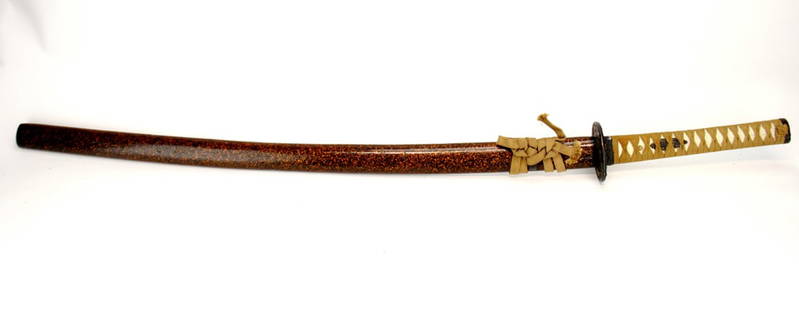
Japanese Muromachi Steel & Lacquered Wood Wakizashi
Similar Sale History
View More Items in Weapons & ArmorRelated Weapons & Armor
More Items in Japanese Weapons & Armor
View MoreRecommended Collectibles
View More




Item Details
Description
East Asia, Japan, late Muromachi period, ca. third quarter of the 16th century CE. A beautiful wakizashi with a single-edged blade, a lacquered (urushi) wood scabbard (saya), and a handle (tsuka) wrapped with reptile skin and cotton straps (tsuka-ito) topped with a brass cap (kashira). A pair of handle ornaments (menuki) depict two mice on one side and a bird resting near a leaf on the other. The minimalist hand guard (marugata tsuba) rests between a pair of copper blade caps (fuchi). The shinogi-zukuri steel blade has a higher ridge line than the typical shobu-zukuri design, a diamond-shaped (iori-mune) profile, and a gently curved tip (chu-kissaki), all forged by the tight-grained hammer-folding process (itame-hada) with an irregular wavy temper pattern (gunome-choji). The blade tang has been intentionally shortened (o-suriage) to better accommodate the handle. Size (w/ sheath): 2.56" W x 32.1" H (6.5 cm x 81.5 cm); (blade): 19.9" L (50.5 cm)
This traditional Japanese sword was both a weapon and a symbol of authority and social status. The wakizashi paired with the longer katana sword marked the wearer as a samurai. The shorter sword was seen as an auxiliary weapon, also used for fighting in close quarters. Wakizashi could also be worn by non-samurai if worn alone, and members of the merchant class (chonin) wore them because of the frequency of encountering bandits when traveling between Japan's cities.
Over the centuries that katana and wakizashi were made, the process of their manufacture became heavily regulated. For example, in 1683, the Tokugawa Shogunate made laws concerning the maximum size of katana and wakizashi. Meanwhile, once a samurai took ownership of his new weapon, he had to wear it in a highly regulated manner. Wakizashi and katana in this period were both deadly weapons and signs of prestige. The craftsmanship of this piece is evident and reflects hundreds of hours of work.
Provenance: private Jones collection, Boulder, Colorado, USA; ex-private Sacramento, California, USA collection
All items legal to buy/sell under U.S. Statute covering cultural patrimony Code 2600, CHAPTER 14, and are guaranteed to be as described or your money back.
A Certificate of Authenticity will accompany all winning bids.
PLEASE NOTE: Due to recent increases of shipments being seized by Australian & German customs (even for items with pre-UNESCO provenance), we will no longer ship most antiquities and ancient Chinese art to Australia & Germany. For categories of items that are acceptable to ship to Australia or Germany, please contact us directly or work with your local customs brokerage firm.
Display stands not described as included/custom in the item description are for photography purposes only and will not be included with the item upon shipping.
#168333
This traditional Japanese sword was both a weapon and a symbol of authority and social status. The wakizashi paired with the longer katana sword marked the wearer as a samurai. The shorter sword was seen as an auxiliary weapon, also used for fighting in close quarters. Wakizashi could also be worn by non-samurai if worn alone, and members of the merchant class (chonin) wore them because of the frequency of encountering bandits when traveling between Japan's cities.
Over the centuries that katana and wakizashi were made, the process of their manufacture became heavily regulated. For example, in 1683, the Tokugawa Shogunate made laws concerning the maximum size of katana and wakizashi. Meanwhile, once a samurai took ownership of his new weapon, he had to wear it in a highly regulated manner. Wakizashi and katana in this period were both deadly weapons and signs of prestige. The craftsmanship of this piece is evident and reflects hundreds of hours of work.
Provenance: private Jones collection, Boulder, Colorado, USA; ex-private Sacramento, California, USA collection
All items legal to buy/sell under U.S. Statute covering cultural patrimony Code 2600, CHAPTER 14, and are guaranteed to be as described or your money back.
A Certificate of Authenticity will accompany all winning bids.
PLEASE NOTE: Due to recent increases of shipments being seized by Australian & German customs (even for items with pre-UNESCO provenance), we will no longer ship most antiquities and ancient Chinese art to Australia & Germany. For categories of items that are acceptable to ship to Australia or Germany, please contact us directly or work with your local customs brokerage firm.
Display stands not described as included/custom in the item description are for photography purposes only and will not be included with the item upon shipping.
#168333
Condition
Scabbard is perhaps a later addition or replacement of the original; yellow cotton strap on scabbard is modern. Minor abrasions to blade, blade caps, and hand guard, with smoothing to scales on reptile skin handle panels commensurate with age and use, and nicks to areas of blade faces. Wonderful patina throughout. Blade edge is still incredibly sharp, so please handle with caution.
Buyer's Premium
- 26.5%
Japanese Muromachi Steel & Lacquered Wood Wakizashi
Estimate $3,000 - $4,500
6 bidders are watching this item.
Shipping & Pickup Options
Item located in Louisville, CO, usOffers In-House Shipping
Local Pickup Available
Payment

TOP










































































![George Washington Signed Discharge: Partly printed discharge document signed by George Washington, as Commander in Chief of the Armies of the United States. Newburgh, [New York], 4 January 1783. 1 page, ## x ## in. Undersigned by Washin](https://p1.liveauctioneers.com/7226/322253/173251475_1_x.jpg?height=310&quality=70&version=1710004847)
